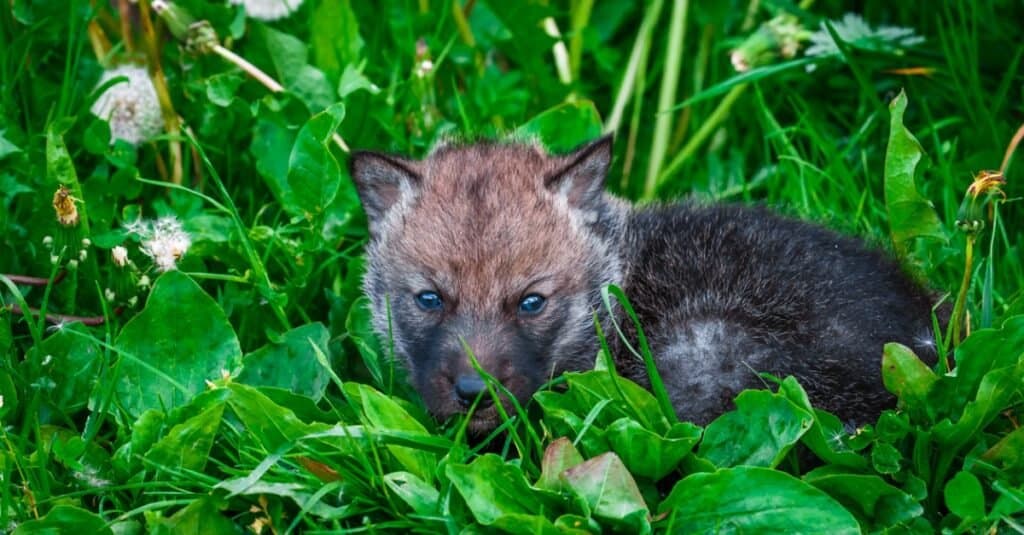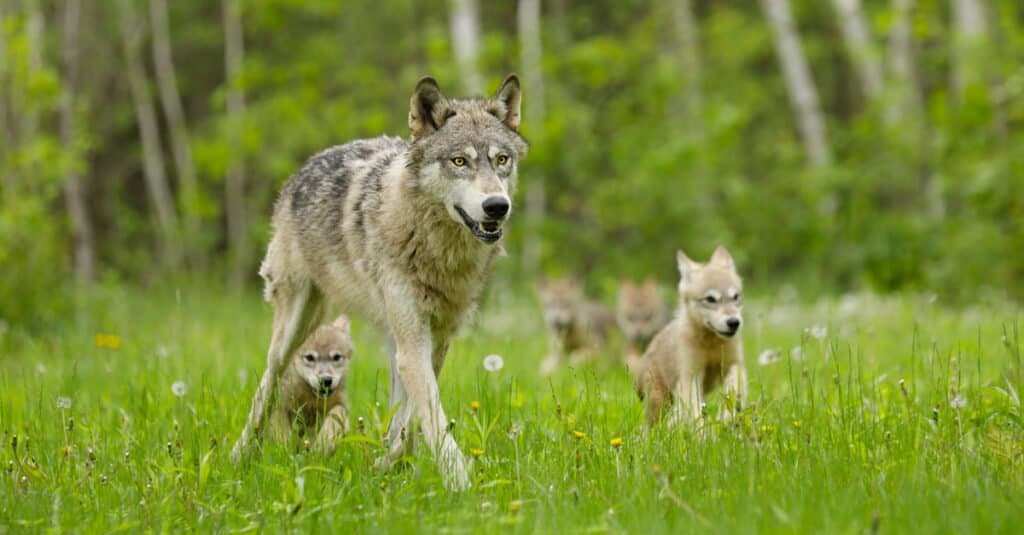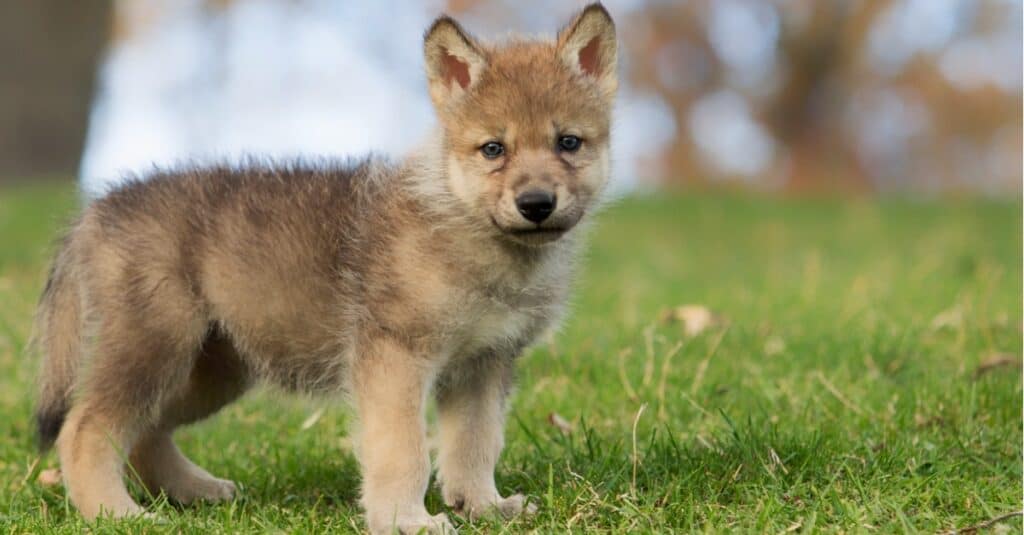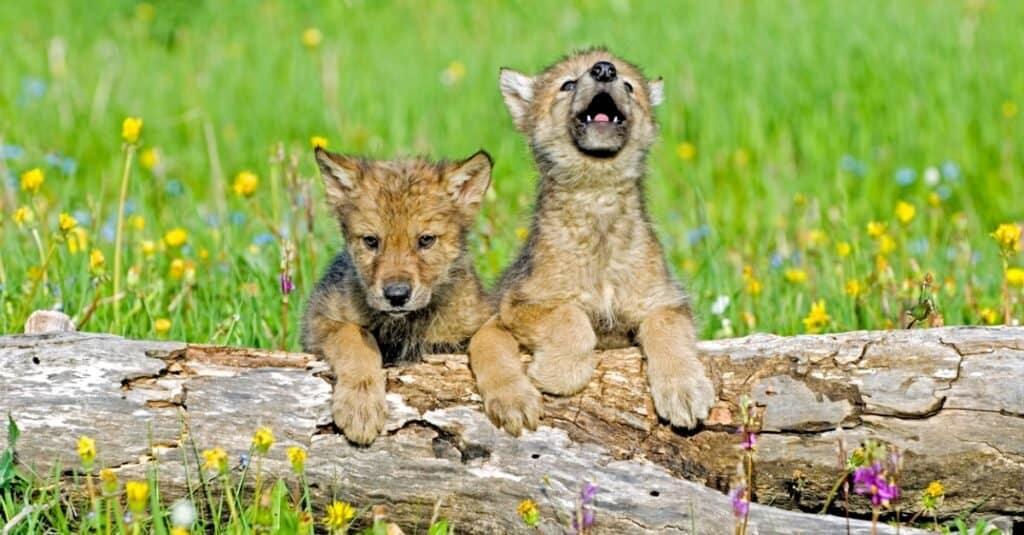Baby wolves are adorable creatures that are born weighing a single pound! They are some of nature’s cutest canines. However, they grow up to be among the most dangerous apex predators in their habitats. But did you know that their deep blue eyes eventually change color as they age? Or that they are not able to hear or see when they are born?
Keep reading to learn seven fantastic wolf pup facts and see some adorable baby wolf pictures.
#1: Baby Wolves Are Born With Deep Blue Eyes

Baby wolves are born with blue eyes that change color as they get older.
©iStock.com/Multipedia
Wolf pups are born with beautiful, light to dark blue eyes. But did you know their eyes don’t stay this color? Wolf pups inherit their eye color from their parents. As pups grow older, their eyes become darker, eventually becoming a golden yellow, amber, orange, or even green color! Some wolf pups may even grow to have light grey eyes, which can be mistaken for blue eyes from a distance.
Wolf pups’ eyes should change to their adult color by the time they are between six and eight weeks old.
#2: The First Grey Wolf Pups Were Recently Sighted in Colorado for the First Time in 80 Years!

A litter of wolves run through the grass with their mother.
©Kenton D. Gomez/Shutterstock.com
In 2021, a pack of grey wolves was seen in Colorado by a biologist and a wildlife manager for the first time in 80 years. Before this, grey wolves were not in the area because people poisoned and hunted the animals in the 1940’s.
Colorado decided to introduce two adult wolves, named “John” and “Jane” to the area. A few months later, they were spotted with three adorable wolf babies!
#3: Baby Wolves are Deaf and Blind at Birth

Mother wolves are fiercely protective of their babies.
©iStock.com/slowmotiongli
When baby wolves are born, their eyes are shut and their eyes and ears are not fully developed. Because of this, these tiny canines are completely unable to see or hear as newborns. After a few days, wolf pups are able to open their eyes, but they still rely on their mothers and their sense of smell to navigate the world around them.
Baby wolves eventually grow up to have excellent hearing. Some wolves can even hear noises that are up to six miles away. Now those are some good ears!
#4: Baby Wolves are Seriously Tiny!

Wolf pups weigh only one pound as newborns!
©iStock.com/Lynn_Bystrom
Mother wolves only carry wolf babies for about two months before they are born. They can have anywhere between four and six wolf pups in a litter. When these babies are born, they weigh in at a single pound.
Even though they are born small, wolf pups pack on the pounds fast. Male wolf pups gain an average of 3.3 pounds a week. Females gain around 2.6 pounds in the same amount of time. Depending on what type of wolf they are, these adorable babies can grow up to be up to 175 pounds fully grown.
#5: Only a Few Females in a Wolfpack Have Babies

The alpha female and alpha male in a wolfpack are the only members to have babies.
©iStock.com/slowmotiongli
Even though there are many females in the typical wolfpack, only the alpha male and alpha female wolves mate to have babies. Wolves do this to breed the strongest babies that have the best chance of surviving despite predators and the harsh environment they live in. This is also a great way for wolves to minimize the number of pups in the wolfpack at one time. This is because having too many babies can put the rest of the pack at risk.
Every member of the pack plays a part in taking care of these wolf babies. Other female wolves help babysit wolf pups and the males work to protect them from threats.
#6: Wolf Pups Only Stay with Their Mothers for Two Years

Two grey wolf pups hang out on a log.
©iStock.com/JohnPitcher
It might sound a little crazy for a two-year-old to venture away from its mother, but for wolf pups, this is completely normal! Once a baby wolf turns 2, it will separate from the pack it was born into and travel away on its own. Some baby wolves go on to join other packs, but others will remain on their own – these are called lone wolves.
#7: Wolf Pups are Only Born in the Winter

Baby wolves learn how to howl from their mothers.
©critterbiz/Shutterstock.com
Since wolves only have one reproductive cycle a year, wolf pups are only born once per year, usually somewhere between January and March. Baby wolves are born in a den and their mothers birth them without any help from the other wolves in the pack.
The photo featured at the top of this post is © iStock.com/Lynn_Bystrom
FAQs (Frequently Asked Questions)
What are baby wolves called?
Wolf babies are called pups. A set of baby wolves born to the same mother at the same time is called a litter.
How much do baby wolves weigh?
Baby wolves usually weigh about one pound when they are born, but male wolf pups gain about 3.3 pounds a week and females about 2.6 pounds until they are fully grown.
What do wolf pups eat?
Baby wolves survive exclusively on their mother’s milk for the first six weeks of their lives. In fact, when they are born, baby wolves can’t chew at all – their tiny mouths can only suckle. After that, they travel with adult wolves who hunt food for them.
How long do mother wolves carry wolf babies?
Female wolves carry baby wolves for about two months before they are born.
Where do wolf pups live?
Wolf pups live across North America, Mexico, Japan, and Western Europe.
Thank you for reading! Have some feedback for us? Contact the AZ Animals editorial team.






